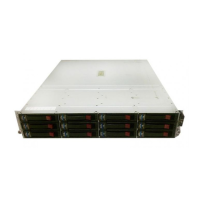where:
• V is the data transfer speed between a host and the primary storage system.
• t is the length of time until the delta resync operation starts.
CAUTION: The recommended journal volume capacity is 6 GB or more. If the capacity is less
than 6 GB, system performance may decrease due to the following:
• The new data cannot be stored because the journal volume is full.
• The performance of the initial copy decreases because the journal volume is full.
• The journal group is suspended because the journal volume is full.
• The indication of Usage Monitor is invalid.
Calculating the journal size
You calculate the size of journal volumes using write-workload and RPO.
To calculate the journal size
• Follow the instructions in (page 21).
• Use your system's peak write-workload and your organization's RPO to calculate the journal
size. For example:
RPO = 2 hours
Write-workload = 30 MB/sec
Calculate write-workload for the RPO. In the example, write-workload over a two-hour period
is calculated as follows:
30 MB/second × 60 seconds = 1800 MB/minute
1800 MB/minute × 60 minutes = 108,000 MB/hour
108000 MB/hour × 2 = 416,000 MB/2 hours
Basic journal volume size = 416,000 MB (416 GB)
Journal volume capacity and bandwidth size work together. Your strategy for protecting data may
allow you to adjust the bandwidth or the size of journal volumes. For a discussion on sizing
strategies, see (page 35).
NOTE: If you are planning for disaster recovery, the remote array must be large enough to handle
the production workload, and therefore must be the same size as master journals. If you are not
planning for disaster recovery, remote journal volumes may be smaller than master journal volumes.
Planning journals
Continuous Access Journal manages pair operations for data consistency through the use of journals.
Continuous Access Journal journals enable update sequence consistency to be maintained across
a group of volumes.
Understanding the consistency requirements for an application (or group of applications) and their
volumes will indicate how to structure journals.
For example, databases are typically implemented in two sections. The bulk of the data is resident
in a central data store, while incoming transactions are written to logs that are subsequently applied
to the data store.
If the log volume “gets ahead” of the data store, it is possible that transactions could be lost at
recovery time. Therefore, to insure a valid recovery image on a replication volume, it is important
that both the data store and logs are I/O consistent by placing them in the same journal.
Sizing journal volumes 23

